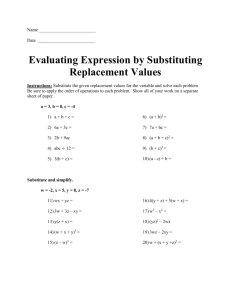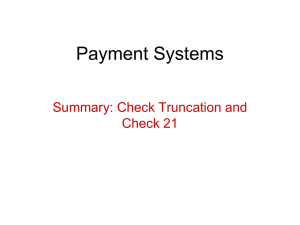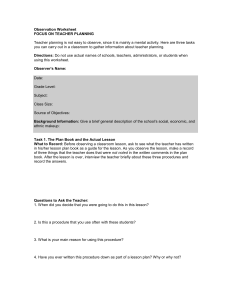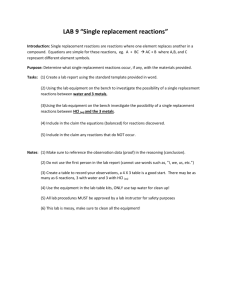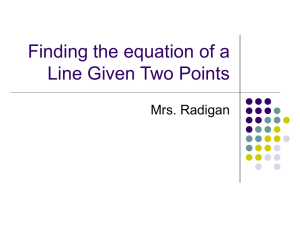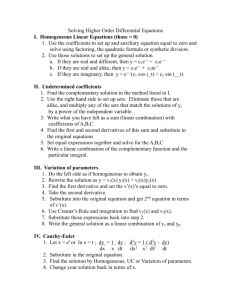Open Sentences
advertisement
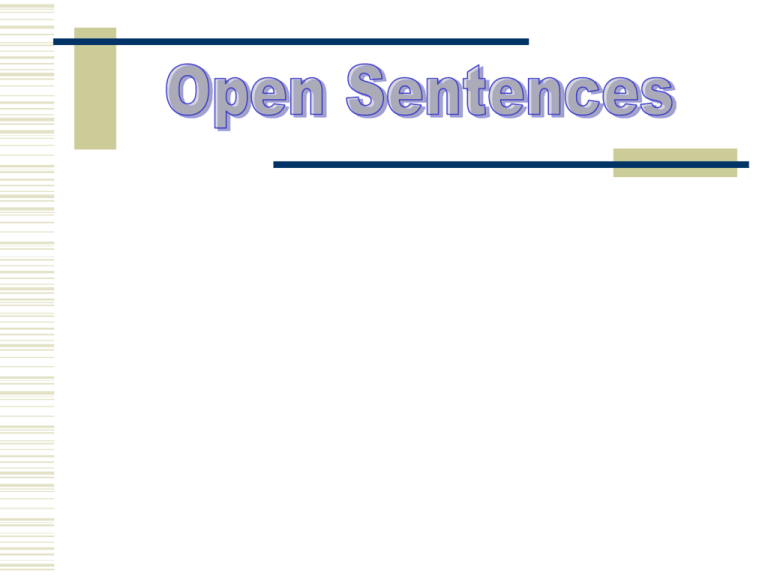
•Open Sentence – a mathematical statement (sentence)
that contains one or more variables, or unknown
numbers.
•An open sentence is neither true nor false until the
variable(s) have been replaced by intended values called
replacement sets.
•Replacement set – intended values or a set of numbers
that are substituted into an equation to determine if they
are solutions or if they satisfy the open sentence.
•Solving the open sentence – Finding a value from the
replacement set that will make the open sentence a true
statement. An open sentence may have more than one
solution.
•Solution – The replacement number that actually
makes the equation a true statement. An open sentence
may have one solution, several solutions, or no
solutions.
•Set – A collection of objects or numbers. Sets are
represented by using braces {}.
•Element – Each object or number in the set is called an
element, or member of the set.
•Sets are named by using capital letters. Examples of
sets are A = {1,2,3,}; B = {6,8,10}; C= {1,2,3,6,8,10}
•The Solution set of an open sentence is the set of all
replacements for the variable that will satisfy or make
the equation true.
•Equation – An equation states that two expressions are
equal. The expressions can be variable or numeric and
are represented on each side of an equal sign.
Equations are
separated by an
equal sign
n 3 10
Variable
Expression
Numeric
Expression
State whether the equation is true or false for the given value of the variable.
1. 15 x 18; x 3
15 3 18
Substitute 3 into the equation for
the variable x and solve.
True when x = 3
2. 35 x 27; x 7
35 7 27
False when x = 7
Substitute 7 into the equation
for the variable x and solve.
Separating an
equation by a
semi-colon and
indicating the
value of the
variable means
to substitute the
number into the
equation to see
if it is a true
solution.
State whether the equation is true or false for the given value of the variable.
1. 6 x 18; x 3
16 3 18
Substitute 3 into the equation for
the variable x and solve.
True when x = 3
2. 32 x 15; x 2
32 2 15
False when x = 2
Substitute 2 into the equation
for the variable x and solve.
Separating an
equation by a
semi-colon and
indicating the
value of the
variable means
to substitute the
number into the
equation to see
if it is a true
solution.
Find the solution or solutions for the equation for the given replacement set.
x 9 15;{5,6,7}
Substitute each value in the
replacement set for the variable x.
1. x 9 15
5 9 15
14 15
False when x = 5
Separating an equation by a semi-colon and
indicating the value of the variable means to
substitute the number(s) into the equation to
see if they are a true solution.
2. x 9 15
6 9 15
15 15
True when x = 6
3. x 9 15
7 9 15
16 15
False when x = 7
The solution of the
equation x + 9 = 15 is x = 6
Find the solution or solutions for the equation for the given replacement set.
x 12 42;{56,58,60}
Substitute each value in the
replacement set for the variable x.
1. x 12 42
56 12 42
44 42
False when x = 56
Separating an equation by a semi-colon and
indicating the value of the variable means to
substitute the number(s) into the equation to
see if they are a true solution.
2. x 12 42
58 12 42
46 42
False when x = 58
3. x 12 42
60 12 42
48 42
False when x = 60
The solution of the equation x - 12 = 42 is No Solution
given the replacement set {56,58,60}.
Find the solution or solutions for the equation for the given replacement set.
2 x x x;{whole numbers }
Substitute any whole number value
in the replacement set for the
variable x.
1. 2x x x
2(5) 5 x5
10 10
True when x = 5
Separating an equation by a semi-colon and
indicating the value of the variable means to
substitute the number(s) into the equation to
see if they are a true solution.
2. 2x x x
210 10 10
20 20
True when x = 20
3. 2x x x
2(20) 20 20
40 40
True when x = 20
The solution of the equation 2x = x + x is true for any whole number
value. This is called having many solutions or infinite solutions.
•Equations are separated by equal signs.
•Mathematical sentences that have symbols separating
each side; such as <, , , or are called inequalities. The
symbols are called inequality symbols.
• < means less than, means less than or equal to,
means greater than, means greater than or equal to.
x 3 12
3x 24
x 5 32
2x 1 36
Find the solution or solutions for the equation for the given replacement set.
x 3 12;{8,9,10}
Substitute each value in the
replacement set for the variable x.
1. x 3 12
8 3 12
11 12
True when x = 8
Separating an inequality by a semi-colon and
indicating the value of the variable means to
substitute the number(s) into the inequality
to see if they are a true solution.
2. x 3 12
9 3 12
12 12
False when x = 9
3. x 3 12
10 3 12
13 12
False when x = 10
The solution of the equation x + 3 < 12 is true when x = 8. Therefore,
the solution set for x + 3 < 12 is {8}.
Find the solution or solutions for the equation for the given replacement set.
3 x 24;{7,8,9}
Substitute each value in the
replacement set for the variable x.
1. 3x 24
3(7) 24
21 24
False when x = 7
Separating an inequality by a semi-colon and
indicating the value of the variable means to
substitute the number(s) into the inequality
to see if they are a true solution.
2. 3x 24
3(8) 24
24 24
True when x = 8
3. 3x 24
3(9) 24
27 24
True when x = 9
The solution of the equation 3x 24 is true when x = 8 and x = 9.
Therefore, the solution set for 3x 24 is {8,9}.
